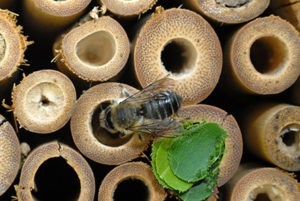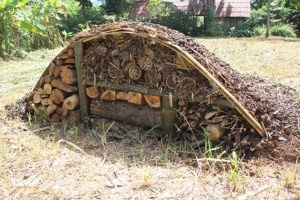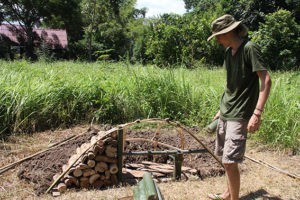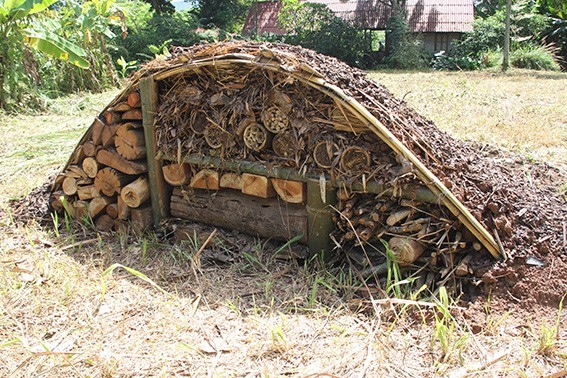A New Resort at Pha Tad Ke BG…
‘Bug hotels’ have been in vogue for a good few years now in the western World, and if you are from a western country, the chances are that you have come across them and are familiar with the concept. The idea is to provide invertebrates (the main focus being on insects) with an enticing and vast array of potential lodgings, in the hopes of supporting a correspondingly vast array of species. Happily, a lot of people are now cottoning on to the fact that these creatures are essential to us, and to the planet as a whole.
Invertebrates are fundamental to the functioning of most ecosystems, not to mention agriculture, in everything from nutrient cycling to pollination to soil aeration to supporting entire food webs. Currently invertebrates are facing something of a crisis due substantially to modern agriculture, habitat disruption and climate change. Even those people who aren’t unashamedly potty about creepy-crawlies are doing their bit by creating, in successful cases, refugia for them.

A solitary bee has found a bumble abode… Photo from Grow Wild UK
In Laos, where people’s removal from nature in everyday life is less stark, the notion of going out of one’s way to increase the already significant plethora of biting, buzzing and stinging critters is, to put it lightly, bewildering. However, as Laos’ only botanical garden, adjacent to its tourist hub and therefore making us an ambassador for conservation within the country, we (well, some) thought a bug hotel was long overdue.
Pha Tad Ke BG already has an area which has been given over to nature to a greater extent than the rest of the garden. In this ‘wild patch’ the grass has been left to grow long, and wild flowers, such as Bidens pilosa and Chromoleana odorata, allowed to proliferate. Needless to say, it already supports many invertebrates, most noticeably Lepidopterans (butterflies and moths), Orthopterans (grasshoppers, crickets and katydids) and Hemipterans (true bugs), but this by no means makes further features superfluous. Heterogeneity within a habitat creates more niches. The more niches that exist, the more species that are likely to find a set of conditions in which they compete as well as, or better than, any other species present, and so the more species an environment can support.
Ideally, a habitat or ecosystem will exhibit so-called ‘self similarity’ when it comes to heterogeneity, which is a recurring theme in nature. Just as a mountain viewed from a distance looks similar in form to one of the rocks it is composed of, which in turn look much like one of the tiny grains it is comprised of when viewed under a microscope, so it is possible for a habitat to have high heterogeneity on multiple scales. A disorderly pile of sticks, logs and leaves from many different trees is in itself heterogeneous, but it also makes the broader area more various, as well as encouraging a diverse assemblage of beneficial fungi, bacteria and invertebrates on a far smaller scale. Thanks to the invertebrates’ basal roles in ecosystems, having different species can attract new specialist predators, which would perhaps feed only on a very specific group of insects, or new plants which are more particular when it comes to pollination. Suffice to say, a bug hotel is a good place to start if one is looking to increase biological diversity in a given area.

The finished article! We’ve cut back the meadow around the hotel to encourage new growth and plant diversity. It’ll all grow back in a few weeks.
Of course, we wanted our bug hotel to be more than a disorderly pile of sticks, logs and leaves. This would be a bug hotel such as the World had never seen. The idea was to create a thriving habitat which would blend in with the rest of the wild patch while still offering people a tantalising glimpse of what lies within. Essentially, we built both an above- and below-ground section, and covered it with earth so that in time it will be covered by the plants that currently surround it; a living roof, as it were. The hope is that this will have multiple advantages: a soil layer should moderate the temperature, retaining warmth at night during the cooler dry season, and protecting from the heat of the sun during the day. One of its main uses will be as a shelter during the wet season, so this soil layer should also keep the worst of the rain off. Finally, having a portion below ground will provide a cooler, damper zone which harbours a different suite of invertebrates. If successful, the results will be seen by visitors though out the wild patch and perhaps the whole garden, the expectation being that it will bring in new members of many exciting insect orders. It would be particularly nice to see more beetle, butterfly, bee and true bug (Hemiptera) species.
If this all sounds interesting to you then why not have a go yourself? Instructions for our design can be found here: Bug Hotel Instructions.
Glossary
Heterogeneity – Variation, diversity-the opposite of homogeneity and uniformity. In ecology, this can apply to many things including ecosystem structure (defined often by landforms and the larger plants), species composition, soil structure and content, and so on. All of this acts to enhance biological diversity.
Niche – In very basic terms, a niche is the area inhabited by a given organism or species. But more than that, it is where that organism fits into all the ecosystem processes, such as the food web and the nutrient cycle. An available niche is not just a physical unfilled space (there are plenty of those), it is a gap in the whole functioning of the ecosystem, which a suitable species would be able to fill.
Refugium (plural = refugia) – An area in which a population of organisms can survive through a period of unfavourable conditions.

Jon hard at work on the bug hotel construction.
This guest blog was kindly written for us by Jon Wells, who volunteered at PTK in 2017. Edits by Bryony Smart, PTK Botanist.
Image credits:
Photograph of the bee from: https://www.growwilduk.com/content/everything-you-need-know-about-solitary-bees



